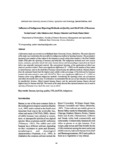Please use this identifier to cite or link to this item:
https://cris.library.msu.ac.zw//handle/11408/1820Full metadata record
| DC Field | Value | Language |
|---|---|---|
| dc.contributor.author | Gama, Tsvakai | - |
| dc.contributor.author | Jazi, Alice T. | - |
| dc.contributor.author | Takawira, Marjory | - |
| dc.contributor.author | Chiota, Wendy M. | - |
| dc.date.accessioned | 2016-09-19T07:11:51Z | - |
| dc.date.available | 2016-09-19T07:11:51Z | - |
| dc.date.issued | 2015 | - |
| dc.identifier.uri | http://hdl.handle.net/11408/1820 | - |
| dc.description.abstract | A laboratory study was carried out at Midlands State University, Gweru, Zimbabwe. The main objective of the study was to determine the most effective indigenous method of ripening bananas. The parameters measured were number of days taken by the bananas to reach colour plate number 6, the Total Soluble Solids (TSS) after the ripening of bananas and shelf life. The indigenous methods used were acacia leaves, tomatoes, and ashes mixed with water, banana leaves and banana fingers taken from the bunch left to ripe naturally (untreated control). The conventional ripening, of the application of ethrel was used as a positive control. There were significant differences (P = 0.001) on the number of days taken to ripen bananas, and on the shelf life of bananas ripened using the different methods. Banana fingers from the untreated bunch had the highest total soluble solids percentage (11%) followed by bananas treated with ashes mixed in water with (10.167%). There were significance differences (P = 0.001) on banana colour using different indigenous methods. Considering the ripening colour, use of tomatoes and ethrel showed the best colour. It is therefore recommended that the use of ripe tomatoes be adopted by smallholder farmers. Ethrel treated banana fingers and the untreated banana fingers showed highest days for banana shelf life. The results of the study showed that ripened tomatoes can be used in ripening of bananas in as much the same way as ethrel. | en_US |
| dc.language.iso | en | en_US |
| dc.publisher | Midlands State University | en_US |
| dc.relation.ispartofseries | Midlands State University Journal of Science, Agriculture and Technology;Special edition; p. 24-33 | - |
| dc.subject | Banana, ripening, quality, TSS, shelf life, indigenous | en_US |
| dc.title | Influence of indigenous ripening methods on quality and shelf life of bananas | en_US |
| dc.type | Article | en_US |
| item.openairecristype | http://purl.org/coar/resource_type/c_18cf | - |
| item.grantfulltext | open | - |
| item.languageiso639-1 | en | - |
| item.openairetype | Article | - |
| item.fulltext | With Fulltext | - |
| item.cerifentitytype | Publications | - |
| Appears in Collections: | Research Papers | |
Files in This Item:
| File | Description | Size | Format | |
|---|---|---|---|---|
| bananas.pdf | Full Text | 6.24 MB | Adobe PDF |  View/Open |
Page view(s)
204
checked on Dec 3, 2025
Download(s)
494
checked on Dec 3, 2025
Google ScholarTM
Check
Items in MSUIR are protected by copyright, with all rights reserved, unless otherwise indicated.



